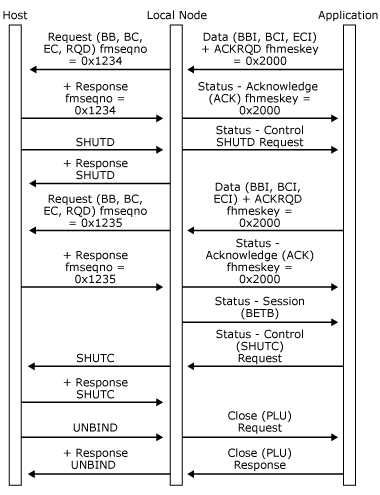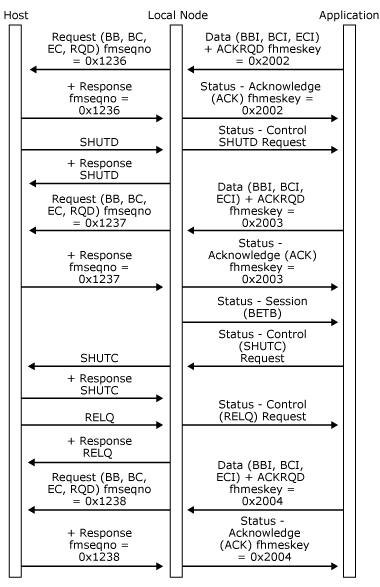Shutdown
The shutdown protocol provides a means for the host application to stop the application from sending any further normal flow requests. This protocol is used when the host application wants to end the session in an orderly manner and is only available for sessions using function management (FM) profile 3 or 4.
If the local node receives a SHUTD request from the host, it issues a Status-Control(SHUTD) Request (without ACKRQD) to request the application to enter a quiesced state at a convenient time. The application determines what is convenient. For example, it could be after a Status-Session(BETB) has been received.
When the application decides it is ready to quiesce, it should issue a Status-Control(SHUTC) Request (again without ACKRQD) to indicate this transition. The local node will notify the host of this change by sending a SHUTC request. The host can continue sending normal flow outbound requests and can subsequently take one of the following actions:
The host terminates the primary logical unit (PLU) session by sending an UNBIND request. The local node closes the PLU connection by sending a Close(PLU) Request to the application. The system services control point (SSCP) session remains active.
The host abandons the shutdown procedure by sending an RELQ request. The local node sends a Status-Control(RELQ) Request (with ACKRQD) to the application to indicate that it can now resume sending on the PLU session. RELQ is only supported on sessions using FM profile 4.
The host resets the session by sending CLEAR, a Transmission Service profile (TS profile) 3 or 4. One of the effects of this is to release the quiesced state. (For more information, see Recovery.)
The following two figures illustrate the shutdown protocols between the local node and the application and how those protocols relate to the underlying SNA protocols.
In the following figure, the host sends SHUTD while the application is sending in the in-bracket state. The application completes the bracket, sends Status-Control(SHUTC) Request, and the host terminates the PLU session by sending UNBIND. The local node closes the PLU connection.

Host sends SHUTD while the application is sending in the in-bracket stateIn the following figure, the host sends SHUTD while the application is sending in the in-bracket state. The application completes the bracket, sends Status-Control(SHUTC) Request, and then the host releases the application from the quiesced state by sending RELQ. The local node sends a Status-Control(RELQ) Request to the application, which initiates a new bracket.

Host sends SHUTD while the application is sending in the in-bracket state
See Also
Opening the PLU Connection
PLU Session
Outbound Chaining
Inbound Chaining
Segment Delivery
Brackets
Direction
Pacing and Chunking
Confirmation and Rejection of Data]
Shutdown and Quiesce
Recovery
Application-Initiated Termination
LUSTATs]
Response Time Monitor Data